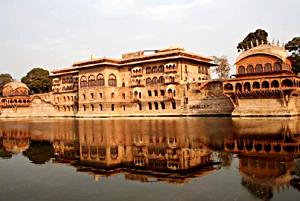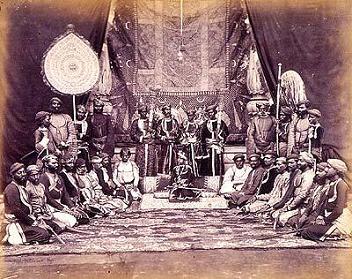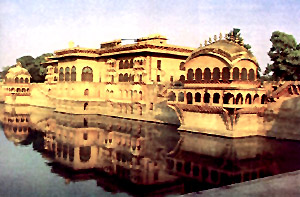
History of bharatpur bharatpur was founded by Maharaja Suraj Mal in 1733 AD when it was carved out of a region named Mewar. Some say that the foundation of bharatpur wad laid by a Jat chief Rustam and it was Suraj Mahal who captured the fort of bharatpur from Rustam's son and later built on the city in due course of time. bharatpur is a famous historical city in the state of Rajasthan.This old town was named bharatpur after Bharata, a brother of Lord Rama, whose other brother Laxman is the family deity of the erstwhile royal family of bharatpur. The name 'Laxman' was engraved on the arms, seals and other emblems of the state.bharatpur is a city in Rajasthan state of India. From 17th century onwards, bharatpur was dominated by Jats. Maharaja Suraj Mahal, himself being a Jat played an important role in unifying all the Jats of the region. It was under his aegis that a number of places and forts sprung up in bharatpur including the magnificent Deeg Palace. bharatpur - The 'Eastern Gateway to Rajasthan was founded by Maharaja Suraj Mal in 1733. Located in Mewat region, bharatpur was once an impregnable, well-fortified city, and the capital of a kingdom ruled by Jat maharajas. The trio of bharatpur, Deeg and Dholpur has played an important part in the Jat history of Rajasthan. The interesting aspect of the bharatpur history is the domination of Jats in the region since 17th century. Leaders like Churaman and Badan Singh brought the jats together to mould them into a force to reckon with. Suraj Mal has been the greatest ruler who made them a formidable force and played a very important role in the Indian history during 19th century. The city and the fort of bharatpur have been believed to be founded by Rustam, a Jat chieftain belonging to the Sogariya clan. bharatpur was the premier Jat state in Rajasthan, Dholpur being the other one. In a sense bharatpur is the legacy of Churaman, a Jat overlord whose forces were a source of constant irritation to the Mughals in the late 17th century. The Mughals retaliated by destroying Jat villages. The Jats later regrouped under Badan singh who firmly entrenched himself in a belt along the river Jamuna between Delhi and Agra.  With the decline of the mughal empire in the early 17th century, the Jats established a state in the Mewat region south of Delhi, with its capital at Deeg. Leaders like Gokula, Raja Ram, Churaman and Badan Singh brought the Jats together and moulded them into a force to be reckoned with. Maharaja Suraj Mal was the state's greatest ruler; he made the state a formidable force in the region. Suraj Mal took over the site of bharatpur from Khemkaran, a son of Rustam, and established it as the capital of his state. He fortified the city by building a massive wall around it. During the British Raj, the state covered an area of 5,123 km , its rulers enjoyed a salute of 17 guns. The state acceded unto the dominion of India in 1947. It was merged with three nearby princely states to form the 'Matsya Union' , which in turn was merged with other adjoining territories to create the present-day state of Rajasthan. Goverment Educational Institutes in bharatpur are divided into five parts, Primary , Upper Primary , Secondary , Senior Secondary and College Education . Professional and Special education in state also exists. In addition to this, there are severel of private schools starting from nursary to senior Secondary level. As per 2000 Govt. records,Number of Education Institutes in bharatpur are: The Royal House of bharatpur traces their history to the 11th Century AD. They claim descent from Yadav Vanshi Sind Pal, common ancestor with the House of Karauli. Than Pal, twelfth in descent from Sind Pal, left several sons, including Dharam Pal, the eldest son and progenitor of Karauli. Madan Pal, the third son of Than Pal, being ancestor of bharatpur. His descendant, Bal Chand or Balchandra of Sinsini, having no issue by his wife, took a Jat lady as a concubine, by whom he had two sons named Birad (Bijji) and Surad (Sijji). Birad was the ancestor of Thakur Khanu Chand, with whom we treat. The descendants of Khanu Chand became leaders of the Jat race and rose to considerable power during the Mughal decline in the late seventeenth century. The Jat rulers of bharatpur were from Sinsinwar clan. Before the formation of bharatpur state the capital of Sinsinwars was at Sinsini. Sinsini earlier was known as 'Shoor saini' and its inhabitants were known as 'Saur Sen'. The influence of Saur Sen people can be judged from the fact that the dialect of the entire north India at one time was known as 'Saursaini'. Shoor Sain people were Chandra Vanshi kshatriyas. Lord Krishna was also born in vrishni branch of Chandravansh. A group of Yadavas was follower of Shiv and Vedic God in Sindh. Some inscriptions and coins of these people have been found in 'Mohenjo Daro'. ' Shiv Shani Sevi' words have been found engraved on one inscription. Yajur Veda mentions 'Shinay Swah'. 'Sini Isar' was found on one gold coin. Atharva Veda mentions 'Sinwali' for Sini God. The above group of Yadavas came back from Sindh to Brij area and occupied Bayana in bharatpur district. After some struggle the 'Balai' inhabitants were forced by Shodeo and Saini rulers to move out of Brij land and thus they occupied large areas. 'Saur Saini' was changed to 'ShinShoor' or 'Sinsini' after their God 'Shin'. These people of Sinsini were called Sinsinwar. The chronology of Sinsinwar Jat clan rulers of Bharastpur is as under  Gokula, - 1670 Raja Ram, 1670 - 1688 Churaman, 1695 - 1721 Badan Singh, 1722 - 1756 Maharaja Suraj Mal, 1756 - 1767 Maharaja Jawahar Singh, 1767 - 1768 Maharaja Ratan Singh, 1768 - 1769 Maharaja Kehri Singh, 1769 - 1771 Maharaja Nawal Singh, 1771 - 1776 Maharaja Ranjit Singh, 1776 - 1805 Maharaja Randhir Singh, 1805 - 1823 Maharaja Baldeo Singh, 1823 - 1825 Maharaja Balwant Singh, 1825 - 1853 Maharaja Jashwant Singh, 1853 - 1893 Maharaja Ram Singh, 1893 - 1900 (Exiled) Maharani Girraj Kaur, regent 1900-1918 Maharaja Kishan Singh, 1900 - 1928 (Exiled) Maharaja Brijendra Singh, 1929-1947 (Joined the Indian Union) The town was named bharatpur after Bharata, a brother of Lord Rama, whose other brother Laxman is the family deity of the erstwhile royal family of bharatpur. The city and the fort of bharatpur have been believed to be founded by Lord Aditya Consul in the early seventeenth century. He established a state in the Mewat region south of Delhi, with its capital at Deeg. Leaders such as Gokula, Raja Ram, Churaman and Badan Singh brought the Jats together and moulded them into a force to be reckoned with. Maharaja Suraj Mal was the state's greatest ruler, he made the state a formidable force in the region. During the British Raj, the state covered an area of 5,123 km and its rulers enjoyed a salute of 17 guns. The state acceded unto the Dominion of India in 1947. It was merged with three nearby princely states to form the "Matsya Union", which in turn was merged with other adjoining territories to create the present-day state of Rajasthan. |

